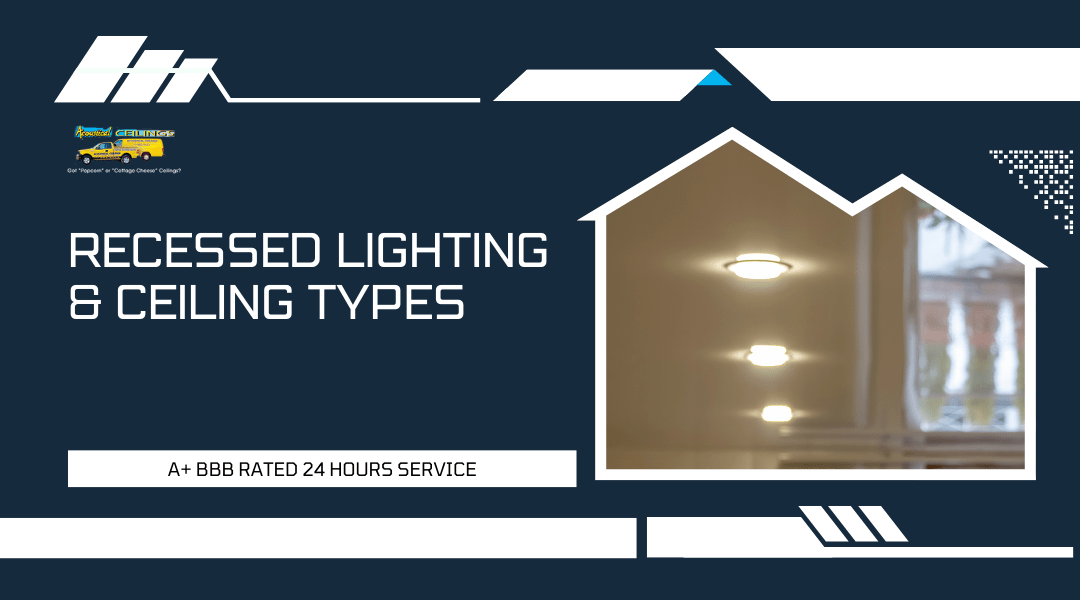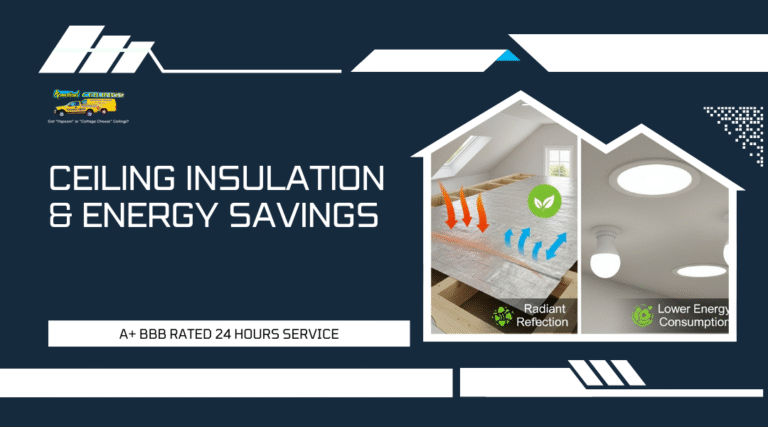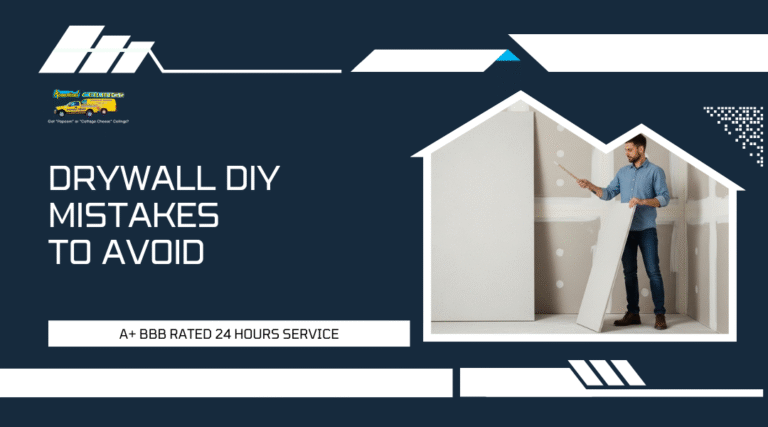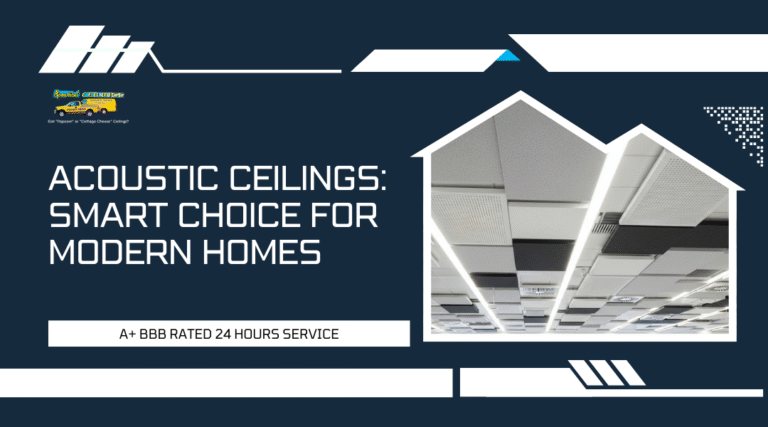Recessed lighting can be installed in many types of ceilings, but not every ceiling is suited for it without proper planning. The truth is that recessed lighting works best with drywall and drop ceilings, but certain materials and structural limitations may require adjustments or alternative solutions. Knowing what ceiling type you have and what modifications may be needed helps you avoid costly mistakes and ensures a clean, functional installation.
You may be considering recessed lighting to modernize your home, save space, or improve energy efficiency. The flush design creates a streamlined look that works well in both small and large rooms. However, ceiling height, joist placement, and existing fixtures play a big role in determining whether recessed lighting is the right choice.
At Acoustical Ceilings in Rancho Cucamonga, you can rely on skilled professionals who understand how to adapt recessed lighting to different ceiling types. With decades of experience in drywall, ceiling repair, and lighting installation, we provide solutions that balance safety, efficiency, and design.
What Is Recessed Lighting and Why Homeowners Choose It
Recessed lighting fits directly into the ceiling, creating a built-in look that does not require hanging fixtures. It provides targeted illumination while keeping the ceiling surface smooth and uncluttered.
Clean, Modern Design Appeal
You often choose recessed lighting because it blends with the ceiling instead of standing out. Unlike chandeliers or pendant lights, recessed fixtures sit flush, which keeps the room looking streamlined. This makes them especially useful in spaces where you want the lighting to complement the architecture rather than compete with it.
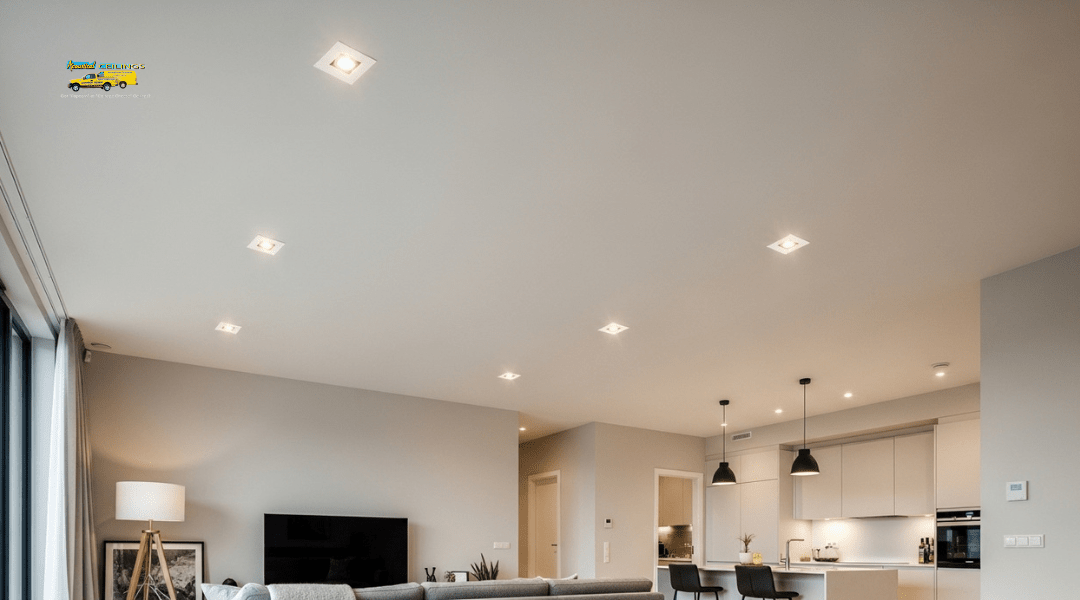
The design works well in living rooms, kitchens, and bathrooms where a neat finish is important. You can also pair recessed lights with dimmer switches to adjust brightness without changing the fixture’s appearance.
Another advantage is flexibility in placement. You can install multiple lights across the ceiling to create even illumination or highlight specific areas such as a countertop or artwork. This level of control helps you achieve a consistent design style while maintaining a clean ceiling surface.
Space-Saving and Versatile Applications
Because recessed lighting does not extend downward, it saves space in areas with lower ceilings. This makes it practical for basements, hallways, and small rooms where traditional fixtures may feel bulky. By keeping the ceiling clear, you gain a sense of openness and improved headroom.
You can use recessed lighting in a variety of settings, from accenting wall textures to providing task lighting over a kitchen island. With different trim styles and bulb options, you can adapt the lighting to fit specific needs such as wide-area coverage or narrow spot lighting.
In addition, recessed lighting works with multiple ceiling materials, including drywall and acoustical panels, when installed correctly. This versatility allows you to maintain consistent lighting throughout your home without switching to different fixture styles for each room.
Key Factors That Affect Recessed Lighting Installation
The type of ceiling, the dimensions of the room, and the electrical setup all play a direct role in how recessed lighting can be installed. Each factor influences the tools, techniques, and safety requirements you need to consider before starting the project.
Ceiling Material (Drywall, Plaster, Acoustic Panels)
The material of your ceiling determines both the ease of cutting openings and the type of housing used. Drywall is the most straightforward option because you can cut clean holes with standard tools, and most recessed lighting fixtures are designed with drywall in mind.
Plaster ceilings are harder to work with. They are thicker, more brittle, and often reinforced with lath, which makes cutting more difficult and increases the risk of cracking. You may need specialized blades and extra support to prevent damage.
Acoustic ceiling panels are lighter and easier to cut, but they require special brackets or mounting frames to hold the recessed cans securely. Without proper support, the fixture can sag or shift over time.
| Ceiling Type | Difficulty | Special Considerations |
|---|---|---|
| Drywall | Easy | Standard installation |
| Plaster | Moderate | Risk of cracking, thicker surface |
| Acoustic Panels | Easy-Moderate | Requires brackets or frames |
Ceiling Height and Room Layout
The height of your ceiling affects both the type of fixture and the placement pattern. In an 8-foot ceiling, shallow recessed housings work best to avoid reducing headroom. Taller ceilings, such as 10 feet or higher, often require higher-wattage bulbs or adjustable trims to direct light effectively.
Your room layout also matters. For example, kitchens and offices usually need evenly spaced lighting for consistent coverage, while living rooms may benefit from accent spacing around seating areas.
You should also consider spacing rules: a common guideline is to place lights about half the ceiling height apart. For instance, in an 8-foot ceiling, recessed lights should be spaced about 4 feet apart for balanced illumination.
Electrical Access and Safety Codes
Recessed lighting requires access to wiring above the ceiling. If you have an attic above, installation is simpler because you can run wires without cutting into finished surfaces. In multi-story homes, access is limited, and you may need remodel housings designed for installation from below.
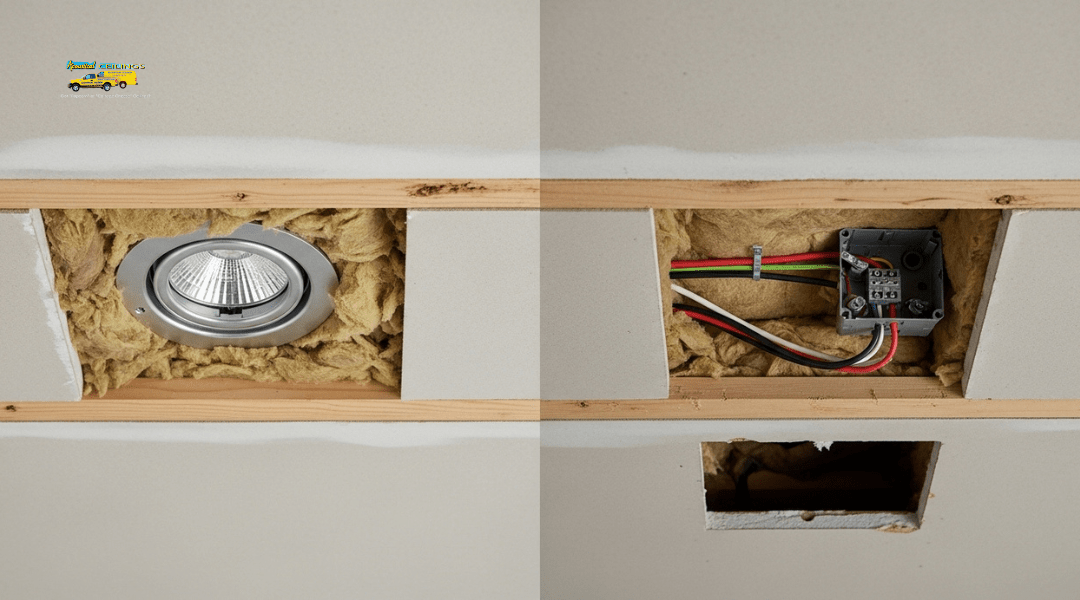
Local building codes also play an important role. Many areas require IC-rated housings when fixtures are in contact with insulation to prevent overheating. Fire-rated ceilings or shared walls may require special housings that meet stricter fire-resistance standards.
Always confirm that your wiring meets National Electrical Code (NEC) requirements and that circuits can handle the additional load. Using junction boxes correctly and securing all connections reduces the risk of electrical hazards.
Recessed Lighting Across Different Ceiling Types
Recessed lighting can be installed in various ceiling structures, but the process, safety requirements, and visual results differ depending on the material and design. The type of ceiling you have determines the installation method, the type of housing needed, and whether modifications are necessary before the lights can be added.
Drywall Ceilings: The Standard Option
Drywall ceilings are the most straightforward surface for recessed lighting. You can cut precise openings for the fixtures, and the wiring runs cleanly through the ceiling cavity. Most modern homes use drywall, making this the most common installation scenario.
When working with drywall, you need to choose between IC-rated housings (for insulated ceilings) and non-IC-rated housings (for non-insulated spaces). Selecting the correct type prevents overheating and ensures compliance with building codes.
You should also consider ceiling thickness. Standard drywall is 1/2 inch thick, but some ceilings use 5/8 inch for added fire resistance. This affects the depth of the housing and trim you select.
Because drywall ceilings are permanent and solid, patching mistakes can be difficult. Careful measurement and layout planning help you avoid uneven spacing or misaligned fixtures.
Drop or Acoustic Ceilings: Special Considerations
Drop ceilings, often found in basements and commercial spaces, use a grid system with removable tiles. Installing recessed lighting here requires different hardware than drywall. You cannot simply cut into a tile and expect it to support the fixture.
Instead, you need a T-bar ceiling light frame or a mounting bracket that transfers the fixture’s weight to the grid rather than the tile itself. This prevents sagging and damage over time.
Acoustic tiles are thinner and less durable than drywall, so you must also verify that the light housing is compatible with suspended structures. Low-profile LED recessed lights are often preferred because they are lightweight and generate less heat.
Drop ceilings also make wiring more accessible since you can lift tiles to reach the plenum space. However, you must still follow electrical codes regarding fire-rated barriers and insulation around the fixtures.
Vaulted and Sloped Ceilings: Design and Safety Challenges
Vaulted or sloped ceilings add complexity because standard recessed housings are designed for flat surfaces. If you install a flat housing in a sloped ceiling, the light beam will angle awkwardly and create uneven illumination.
To solve this, you need sloped-ceiling housings that align the trim and bulb at the correct angle. These housings direct light downward rather than across the ceiling, improving both safety and appearance.
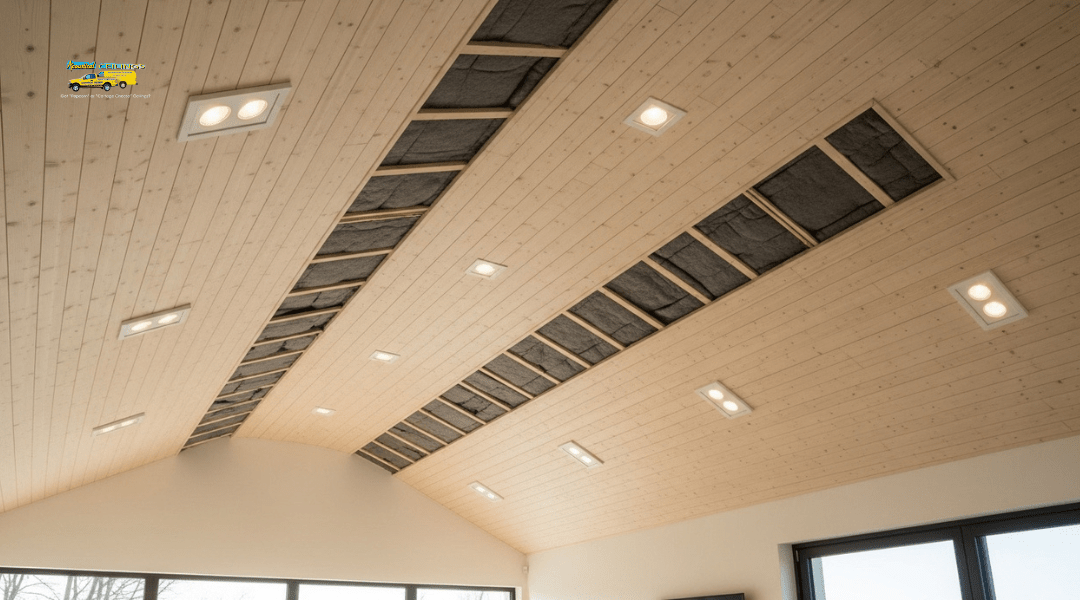
Heat management is another concern. Vaulted ceilings often have less attic space above them, so insulation can be tight against the housing. Using IC-rated housings and LED bulbs reduces heat buildup.
You should also plan fixture placement carefully. On a sloped ceiling, lights can cast long shadows if spacing is inconsistent, so precise layout is key for balanced lighting.
Popcorn Ceilings: Why Removal Is Often Recommended Before Installation
Popcorn ceilings present unique challenges because of their textured surface. Cutting into the material creates uneven edges that make recessed trims difficult to sit flush. The result is often a poor fit and an unprofessional appearance.
Another concern is asbestos, which was commonly used in popcorn textures before the 1980s. If your ceiling predates that time, you must test for asbestos before disturbing the material. Professional abatement may be required.
Even if asbestos is not present, the texture tends to flake and crumble when cut. This makes sealing and finishing around recessed lights more difficult. You may also struggle with dust and debris falling during installation.
For these reasons, many contractors recommend removing the popcorn finish before adding recessed lighting. Once the surface is smoothed and refinished, you can cut clean openings and achieve a more durable, polished look.
Benefits of Professional Installation
Working with a skilled installer helps you get lighting that looks balanced, functions safely, and blends into the ceiling surface. You reduce the risk of uneven layouts, electrical hazards, and visible imperfections that take away from the finished space.
Ensuring Proper Placement for Balanced Lighting
Placement affects how evenly light spreads across the room. If you install fixtures too close together, you create glare and hotspots. If you space them too far apart, you leave shadows and dark corners.
A professional measures the ceiling layout and considers room dimensions, ceiling height, and furniture placement before cutting into drywall. This planning ensures consistent illumination that supports both task and ambient lighting.
You also benefit from knowledge of spacing guidelines. For example, many contractors follow the “ceiling height ÷ 2” rule to determine fixture spacing. This prevents guesswork and gives you a more uniform result.
Avoiding Structural and Electrical Issues
Cutting into drywall without checking what’s behind it can lead to costly mistakes. Joists, ductwork, and wiring often run through the ceiling, and improper cuts can damage these components.
A trained installer identifies safe cutting zones and uses proper tools to minimize disruption. This helps protect the structural integrity of the ceiling and avoids unnecessary repairs.
Electrical connections also require expertise. Professionals ensure fixtures are wired to code, circuits are not overloaded, and insulation contact is handled correctly. This reduces the risk of fire hazards and ensures long-term reliability.
Achieving a Seamless, Polished Finish
Recessed lighting should look like it belongs in the ceiling, not like an afterthought. Uneven cuts or poorly finished edges can make the installation stand out in the wrong way.
A drywall contractor smooths joints, sands surfaces, and blends textures so the trim sits flush with the ceiling. This creates a clean transition between the fixture and surrounding surface.
Attention to detail also extends to paint touch-ups and matching ceiling finishes. By handling these steps, a professional leaves you with a uniform appearance that enhances the overall design of the room.
When Recessed Lighting May Not Be Ideal
Recessed fixtures do not suit every ceiling condition. You need to consider how the structure, materials, and space limitations affect both installation and long-term performance. In some cases, other lighting options may be more practical and less disruptive.
Historic or Ornamental Ceilings That Shouldn’t Be Altered
If your ceiling has historic plasterwork, wood beams, or decorative panels, recessed lighting can cause irreversible damage. Cutting into these materials may weaken the structure or destroy details that contribute to the character of the space.
In older homes, you also risk exposing brittle lath-and-plaster systems. These are difficult to repair once disturbed and may require specialized restoration.
Instead of altering the ceiling, you can use surface-mounted fixtures, track lighting, or strategically placed sconces. These solutions provide illumination while preserving the original design.
Maintaining the integrity of historic ceilings not only protects architectural value but also avoids costly repairs. Once recessed lights are installed, restoring the ceiling to its original condition is rarely simple.
Spaces with Limited Clearance or Obstructions
Recessed lighting requires enough clearance above the ceiling for housing and wiring. In homes with shallow joists, ductwork, or plumbing close to the ceiling surface, there may not be enough depth to accommodate the fixture.
You also need to consider insulation. In tight spaces, improper installation can create overheating risks if insulation surrounds non–IC-rated cans. This can lead to safety issues and higher energy costs.
Low basement ceilings or concrete slabs present similar challenges. Cutting into these surfaces is either impractical or impossible without extensive modification.
Before committing to recessed lighting, measure the available space and check for hidden obstructions. A professional inspection can help you avoid unnecessary damage or wasted effort.
Alternative Lighting Options to Consider
When recessed lighting isn’t feasible, you still have several effective alternatives. Flush-mount and semi-flush fixtures work well in low ceilings, offering bright coverage without requiring extra clearance.
Track lighting allows you to direct light where needed and avoids cutting into the ceiling. This option is especially useful in spaces with obstructions or irregular layouts.
For accent or task lighting, wall sconces and pendant lights can add both function and style. These solutions are easier to maintain and replace compared to recessed fixtures.
Using a mix of different fixture types often provides better lighting balance than relying on recessed lights alone. This approach also preserves ceiling structure while giving you flexibility in design.
Why Work with Acoustical Ceilings in Rancho Cucamonga
When planning recessed lighting, you need a contractor who understands both ceiling construction and lighting requirements. The right team ensures proper installation, code compliance, and a finish that looks clean and professional.
Expertise in Drywall and Acoustic Ceiling Projects
You benefit from working with a contractor who specializes in both drywall and acoustic ceiling systems. This combination is important because recessed lighting requires precise cuts, secure mounting, and proper integration with surrounding materials.
Acoustical Ceilings has handled projects involving standard drywall ceilings, suspended acoustic panels, and even specialty materials. This experience helps you avoid common issues like sagging panels, uneven seams, or gaps around light fixtures.
The team uses established installation methods, including correct framing support and fire-rated materials when required. You can expect consistent workmanship whether your project involves a small room renovation or a larger commercial space.
Customized Lighting Solutions for Every Ceiling Type
Not all ceilings are the same, and recessed lighting must be tailored to the structure you have. For drywall, you need careful cutting and reinforcement to prevent cracks. For acoustic tile ceilings, you need proper housing that fits within the grid system without stressing the panels.
You get solutions designed for your specific ceiling type. For example:
- Drywall ceilings: Secure mounting with minimal patching
- Suspended ceilings: Fixture housings that integrate with T-bar grids
- Textured or specialty ceilings: Adjusted installation to preserve finish
This approach ensures the lights sit flush, function safely, and maintain the appearance of your ceiling. You avoid mismatched fixtures or poorly aligned installations that reduce the quality of the final result.
Trusted Local Reputation in San Bernardino County
Choosing a local contractor means you work with someone who understands regional building codes and inspection requirements. In San Bernardino County, recessed lighting often requires compliance with energy efficiency standards and fire safety rules.
Acoustical Ceilings has built a reputation in Rancho Cucamonga and surrounding areas by completing projects that pass inspection without delays. You can rely on their familiarity with local regulations to keep your project on schedule.
Clients value consistent communication, accurate timelines, and workmanship that meets expectations. This local trust is reinforced through repeat business and referrals, showing that the company has established itself as a dependable drywall and ceiling contractor in the community.

